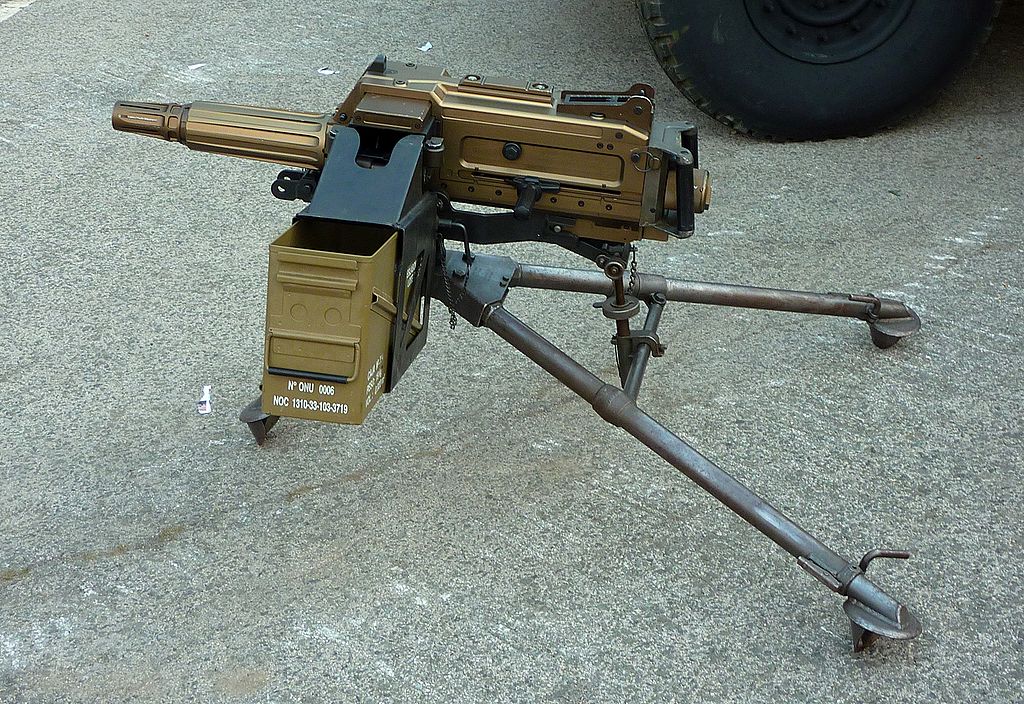Automatic grenade launcher
| The below content is licensed according to Creative Commons Attribution-ShareAlike License contrary to the public domain logo at the foot of the page. It originally appeared on http://en.wikipedia.org. The original article might still be accessible here. You may be able to find a list of the article's previous contributors on the talk page. |

An automatic grenade launcher or grenade machine gun is a grenade launcher firing rounds in quick succession from an ammunition belt or large-capacity magazine.[1][2]
These weapons are often mounted on vehicles or helicopters, as when these weapons are moved by infantry the weapon, its tripod, and ammunition, are a heavy load, requiring a small team of men.[1] The Mark 19 Automatic Grenade Launcher, first used by the Americans during the War in Vietnam, and still widely used today, weighs 62.5 kg, when attached to its tripod, and loaded with a box of ammunition.[2] The popular Mark 19 is capable of indirect fire to 2200 metres, an indirect fire role traditionally reserved for mortars. Even though it carries less explosive than a 60mm mortar, this is thought to be counterbalanced by its higher volume of fire.
The most popular caliber for automatic grenade launchers in the west has been 40mm.[1][2] The Soviet Union successfully fielded a 30mm grenade launcher, the AGS-17 during its war in Afghanistan, and in 2002, Russia introduced a successor weapon, the AGS-30.[3] Traditional munitions for automatic grenade launchers include high explosive, fragmentation, shaped charge for attacking light armored vehicles. Less lethal rounds, like tear gas and sponge rounds, for crowd control, have also been made. In the 21st Century integrated sighting systems started to be sold, capable of detonating air-burst grenades precisely on, above, or behind targets the user designated to the sighting system.[3]
Different weapons use different methods of operation, with the "blowback" and "long recoil" being two popular choices.[1] In all these weapons the energy released by firing the previous round powers loading the next round into the weapon's breech. The popular Mark 19 is automatically reloaded through the blowback method, where expanding gases blow back the firing bolt.
In the long recoil method the bolt is fixed to the firing chamber, and the whole firing chamber is blown back. These weapons are slightly less accurate, but weigh less than blowback weapons.[4] General Dynamics manufactures a long recoil weapon, the Mark 47 Automatic Grenade Launcher, as does the Spanish firm Santa Bárbara. The LAG-40 manufactured by Santa Bárbara has a relatively low rate of fire -- 215 rounds per minute.
References
- ↑ 1.0 1.1 1.2 1.3 "CASW ( Close Area Suppression Weapon System ) Automatic Grenade Launcher — MERX Notice of Proposed Procurement". Canadian American Strategic Review. August 2009. Archived from the original on 2009-06-05. https://web.archive.org/web/20090605221412/http://www.casr.ca/bg-casw.htm. Retrieved 2015-03-09.
- ↑ 2.0 2.1 2.2 "Background – CASW Project – Company Area Suppression Weapon". Canadian American Strategic Review. December 2008. Archived from the original on 2009-08-08. https://web.archive.org/web/20090808073348/http://casr.ca/bg-casw2.htm. Retrieved 2015-03-09. "In its current form, the Mk19 mod 3, this AGL has become the weapon of choice among US ground troops in Iraq – primarily because the AGL offers both direct (to 1600m) and indirect fire (to 2200m)."
- ↑ 3.0 3.1 "A new generation of AGLs: within only a few decades the Automatic Grenade Launcher (AGL) has leapt from the concept stage to becoming a widely accepted and valued infantry support weapon, providing the foot soldier with a highly effective area fire suppression system.". Armada International. 2002-04-01. http://www.thefreelibrary.com/A+new+generation+of+AGLs%3A+within+only+a+few+decades+the+Automatic...-a086195789. Retrieved 2015-03-09.
- ↑ "Background — CASW Candidates Operating Systems – Long Recoil". Canadian American Strategic Review. December 2008. Archived from the original on 2009-08-08. https://web.archive.org/web/20090808073348/http://casr.ca/bg-casw2.htm. Retrieved 2015-03-09. "The long recoil operating system’s obvious advantage is the compact gun body. While this compensates for the weapon’s internal complications, that moving barrel might also result in first-round aiming inaccuracies. The AGL designers are willing to overlook this in exchange for reduced weight (in comparison to a blowback design) and for the portability inherent in a smaller weapon (even if weight reduction is modest). In any case, great accuracy is not the forte of the AGLs."